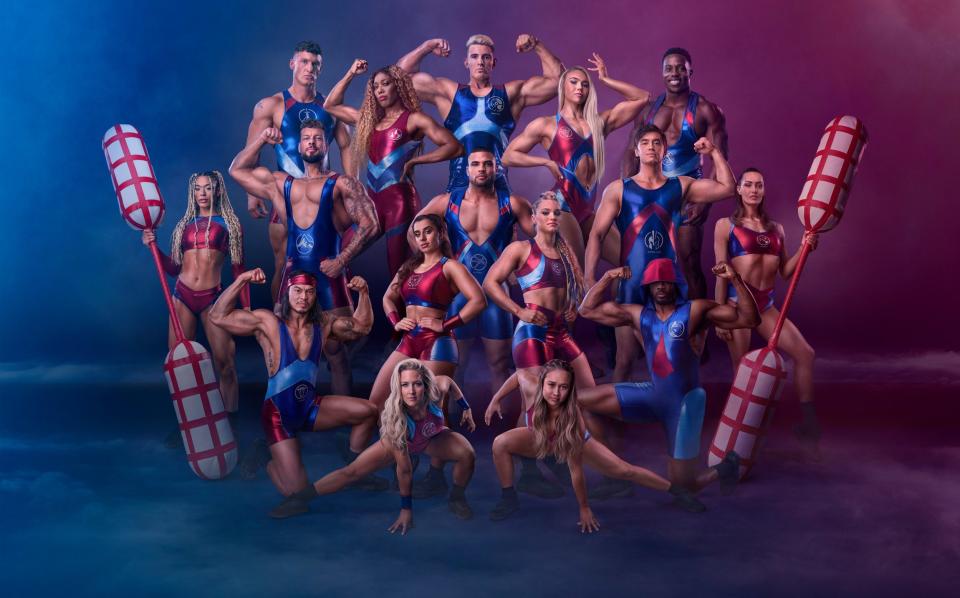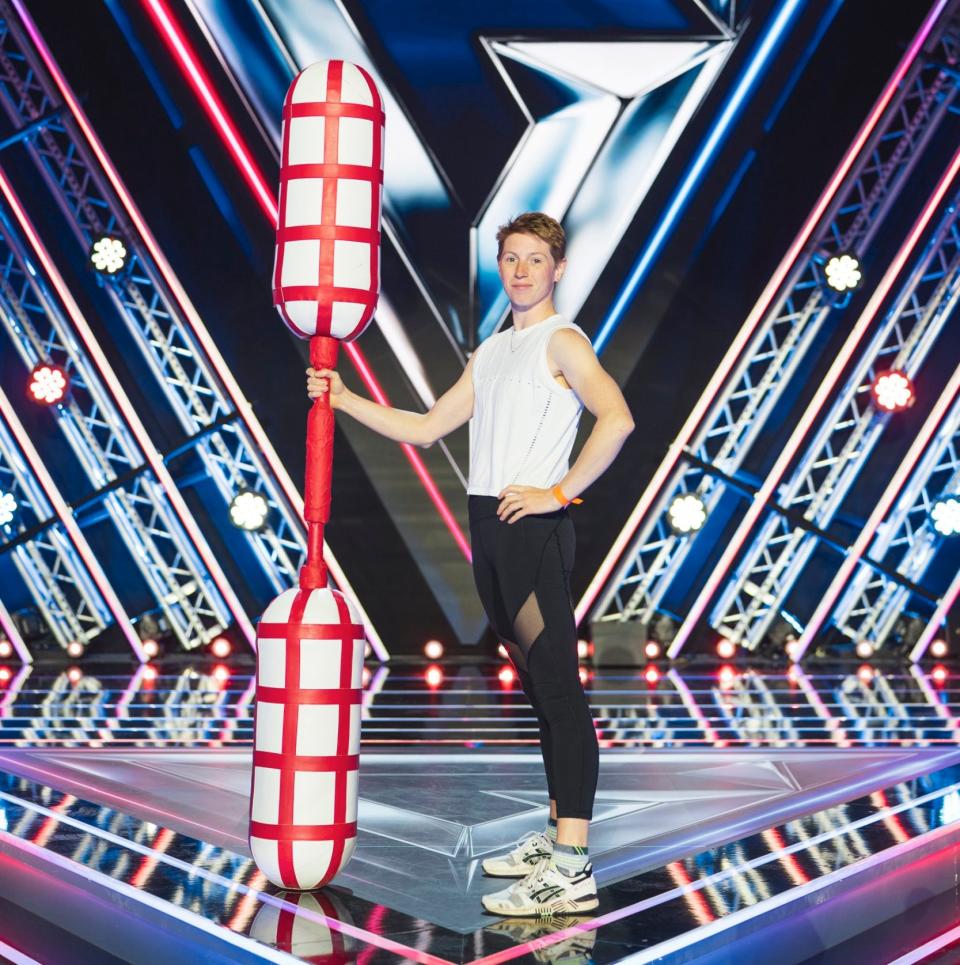What it’s really like to be pummelled by the Gladiators
‘Contender, rrrready?” The distinctive Glaswegian burr of John Anderson can instantly cause any child of the early 1990s to time-travel. Back to an acid-coloured era before the drabness of indie music and heroin chic took over, when a generation of children was mesmerised by the plumped-up muscles and hairsprayed barnets of the Gladiators.
These were children’s entertainers in unitards, raised to mythic status by the gods of Saturday-night television. The primary-school playgrounds of 1992 buzzed with their magic on a Monday morning. All the boys loved Jet. Everyone was scared of Wolf. We argued about whose mum or dad could, hypothetically, make it up the infamous, thigh-burning Gladiators travelator.
It was an era of uncomplicated gender politics. Pamela Anderson’s assets were glibly discussed. The Gladiators’ assets, male and female, were, too. The show channelled an American All-Star style with its baseball-inspired umpires, giant foam fingers and big stadium anthems, all helmed by the perfect smiles of Ulrika Jonsson and John Fashanu. Beamed into our lives in suburban Stockport, it transfixed my school friends and me.
Thirty years later, I’m watching a new generation of smooth-bodied Gladiators strut their stuff. As the likes of Electro, Giant, Diamond and Comet each pull their signature moves to thumping music in front of the television cameras, I feel temporally confused. Not least when Nitro enters to Snap!’s 1990 hit The Power. I brace in my seat for a full-throttle nostalgia fest.

The setting is Sheffield’s Utilita Arena (moved from Gladiators’ spiritual home of Birmingham’s National Indoor Arena). The previous week, the organisers had had to turn away spectators after “unprecedented demand” for free tickets to watch the new series being filmed during half-term. Those childhood fans are now parents and sitting patiently with their own children, as our new hosts, the less glamorous but no less sparkle-toothed Bradley Walsh and his son, Barney, film their treacly cues. In their clean-cut suits, they look like friendly Mormons dropped in from above. Otherwise, little has changed. There’s the same pantomime villainy and bouncing pecs.
This being the social-media age, a large proportion of the 16-strong troupe of Gladiators are drawn from the worlds of Instagram and TikTok. Legend, real name Matt Morsia, has a million Instagram followers on his account MattDoes Fitness. He’s also, formerly, a medal-winning long- and triple-jumper, and a professional powerlifter. By contrast, the 1990s Gladiators were mostly plucked out of the pool of those auditioning to be contenders, and then turned into stars.
This is not the first time the show has been revived. The original ITV series finished in 2000, and then Sky One’s take ran from 2008 to 2009. The BBC has, visibly, poured resources into its revival. Mark Clattenburg, the former Premier League referee, has replaced the beloved Anderson (now 92), and the producers are clearly hoping to recapture some of that Saturday-evening must-watch magic, as well as capitalise on a social-media obsession with fitness and health. Ninja Warrior UK has shown that we’re still suckers for an assault course. And Gladiators offers added theatrical jeopardy.
There are new games to go along with the old favourites. Collision, which involves the Gladiators swinging across to try to knock over the contenders as they collect balls on a precarious rope bridge, joins familiar concepts such as Duel, Hang Tough and, of course, the Eliminator.
With the average Gladiator in their mid-30s, they, like me, were fans as children. “This is the pinnacle,” says Morsia, backstage. “If you’d told my younger self that I was going to be a Gladiator!” he says, without needing to qualify the statement. The same goes for Nitro, real name Harry Aikines-Aryeetey, a Commonwealth and European gold-medallist sprinter. Aged 34, he recalls how Gladiators was a high point of his childhood. “My dad was cabbing at that point and picked up a few of the lads on occasion and came home with a few autographs. That was pretty crazy for me.”
“The world was different then,” says Fire, real name Montell Douglas, with misty-eyed wisdom. A former Team GB sprinter (and Olympic bobsledder), who previously held the British women’s 100-metre record, she adds: “Everyone sat down and watched it on a Saturday night. If you were an athletic child, you wanted to be there.”
With so many of the new Gladiators being fans of the original series, it makes sense why the epic levels of swagger and braggadocio needed are just as natural to them as the push-ups and pull-ups. “I’m the best Gladiator, and I reside in Kent,” says Legend, with posturing bathos. Yes, Wolf was his favourite Gladiator as a child. He had his poster on his wall.
Even Sonia Mkoloma, one of the assistant referees and a former England international netballer, was a fan, which makes me wonder if the whole revival isn’t so much to introduce it to a new generation of kids, as to satisfy a bunch of highly-fit adults.
One of the facets of the original series was its inclusivity. Nitro, who was inspired by the representation of black Gladiators as a boy, says: “The ethos and the morals are still the same, because it’s a family show and we are promoting positivity that everyone gets on board with. And to get you sitting down as a family again.”
A first this time round is the inclusion of a deaf Gladiator. Fury, real name Jodie Ounsley, a professional rugby player for Exeter Chiefs, was born deaf and had a cochlear implant fitted at 14 months old. Some hand signals are used to communicate with her when the games start and end. “When I’m in the games, I’m aggressive, I’m powerful and I’m there to do damage,” she says. “I’m not there to make friends, but afterwards, I’ll want to hug you and be your best mate. Fury has two personalities.”
However, the show stops short of gender-blind competition. Male Gladiators still compete solely against male contenders. As Legend says: “There are obviously genetic differences, male to female. And some of the games, like Duel, you’d have a 140kg [22 stone] guy hitting a 60kg [nine stone] woman. I don’t think audiences would be receptive to that and I don’t think it would be safe, either.” For the record: Bionic’s biceps are 19in; Apollo is 6ft 6in.

As someone who likes fitness but hates competition, I’ve always half-fancied the challenge of the travelator. Sadly, that’s not on offer today. Instead, I have signed up to be hit with pugil sticks and walloped by the Gladiators in the powerball round. I hated netball at school. This is its bloodthirsty equivalent.
Dynamite, 20, real name Emily Steel, the youngest of the new crop and the only one unable to remember the original series, describes herself as “super-friendly”. Soon, she’s walloping me while I’m still in the safe zone and then smiling at me with honey-cloying sweetness. With a background in swimming at national level until she was 15 years old, she’s now a full-time CrossFit athlete. The way I bounce off her, she should have just stuck with the name Steel.
Watching one of the semi-finals being filmed later, I see Fury mercilessly wipe out one of the contenders. Given that her father was a contender in the 2008 Sky reboot, you’d think she might have some dewy-eyed softness for the contenders. Not so. One mother of four is folded in half and dumped on her bum. She can’t breathe. There’s a timeout until she feels ready to limp on, smiling wanly up at the bright stadium lights where, somewhere, her family are waving placards and cheering her on. TV’s cosiest, most brutal Saturday-evening show is back.
Gladiators returns on Saturday on BBC One at 5.50pm